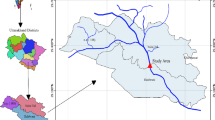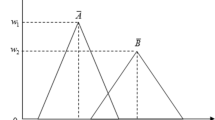Abstract
The trophic state index, and in particular, the Carlson Trophic State Index (CTSI), is critical for evaluating reservoir water quality. Despite its common use in evaluating static water quality, the reliability of the CTSI may decrease when water turbidity is high. Therefore, this study examines the reliability of the CTSI and uses the Back-Propagation Neural Network (BPNN) model to create a new trophic state index. Fuzzy theory, rather than binary logic, is implemented to classify the trophic status into its three grades. The results show that compared to the CTSI with traditional classification, the new index with fuzzy classification can improve trophic status evaluation with high water turbidity. A reliable trophic state index can correctly describe reservoir water quality and allow relevant agencies to address proper water quality management strategies for a reservoir system.




Similar content being viewed by others

References
Biggs, B. J. (2000). Eutrophication of streams and rivers: dissolved nutrient-chlorophyll relationships for benthic algae. Journal of the North American Benthological Society, 19(1), 17–31.
Brezonik, P. L. (1984). Trophic state indices: rationale for multivariate approaches. Lake and Reservoir Management, 1(1), 441–445.
Carlson, R. E. (1977). A trophic state index for lakes. Limnology and Oceanography, 22(2), 361–369.
Chang, S. P., & Chuang, S. M. (2001). Eutrophication study of twenty reservoirs in Taiwan. Water Science & Technology, 44(6), 19–26.
Chang, C. L. & Lin, Y. T. (2014). A water quality monitoring network design using fuzzy theory and multiple criteria analysis. Environmental Monitoring & Assessment, 186(10), 6459–6469.
Chiu, S. W. (2003). Grey relational analysis for the synthetic evaluation of reservoir water quality: case studies of Feitsui and Shihmen Reservoir. National Central University, thesis. (In Chinese).
Icaga, Y. (2007). Fuzzy evaluation of water quality classification. Ecological Indicators, 7(3), 710–718.
Justić, D. (1991). A simple oxygen index for trophic state description. Marine Pollution Bulletin, 22(4), 201–204.
Karul, C., Soyupak, S., Cilesiz, A. F., Akbay, N., & Germen, E. (2000). Case studies on the use of neural networks in eutrophication modeling. Ecological Modelling, 134, 145–152.
Kuo, J. T., Wang, Y. Y., & Lung, W. S. (2006). A hybrid neural–genetic algorithm for reservoir water quality management. Water Research, 40(7), 1367–1376.
Kuo, J. T., Hsieh, M. H., Lung, W. S., & She, N. (2007). Using artificial neural network for reservoir eutrophication prediction. Ecological Modelling, 200(1), 171–177.
Lambou, V. W., Taylor, W. D., Hern, S. C., & Williams, L. R. (1983). Comparisons of trophic state measurements. Water Research, 17(11), 1619–1626.
Liou, Y. T., & Lo, S. L. (2005). A fuzzy index model for trophic status evaluation of reservoir waters. Water Research, 39(7), 1415–1423.
Lu, R. S., & Lo, S. L. (2002). Diagnosing reservoir water quality using self-organizing maps and fuzzy theory. Water Research, 36(9), 2265–2274.
Lu, R. S., Lo, S. L., & Hu, J. Y. (1999). Analysis of reservoir water quality using fuzzy synthetic evaluation. Stochastic Environmental Research and Risk Assessment, 13(5), 327–336.
Palani, S., Liong, S. Y., & Tkalich, P. (2008). An ANN application for water quality forecasting. Marine Pollution Bulletin, 56, 1586–1597.
Sheela, A. M., Letha, J., & Joseph, S. (2011a). Environmental status of a tropical lake system. Environmental Monitoring and Assessment, 180(1–4), 427–449.
Sheela, A. M., Letha, J., Joseph, S., Ramachandran, K. K., & Sanalkumar, S. P. (2011b). Trophic state index of a lake system using IRS (P6-LISS III) satellite imagery. Environmental Monitoring and Assessment, 177(1–4), 575–592.
Sigua, G. C., Williams, M. J., Coleman, S. W., & Starks, R. (2006). Nitrogen and phosphorus status of soils and trophic state of lakes associated with forage-based beef cattle operations in Florida. Journal of Environmental Quality, 35(1), 240–252.
Wu, C. C. (2010). Discussion on the parameters for trophic status evaluation. Taiwan Water Corporation, project report. (in Chinese).
Acknowledgments
The authors would like to thank the National Science Council of the Republic of China for financially supporting this research under Contract No. NSC 100-2221-E-035-072-MY3.
Author information
Authors and Affiliations
Corresponding author
Rights and permissions
About this article
Cite this article
Chang, C.L., Liu, H.C. Applying the Back-Propagation Neural Network model and fuzzy classification to evaluate the trophic status of a reservoir system. Environ Monit Assess 187, 567 (2015). https://doi.org/10.1007/s10661-015-4513-7
Received:
Accepted:
Published:
DOI: https://doi.org/10.1007/s10661-015-4513-7



